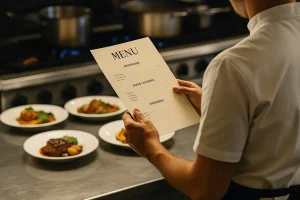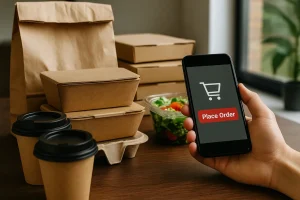Creating a well-thought-out pricing strategy for small restaurants is more than just crunching numbers—it’s a powerful lever to build your brand, shape customer perception, and improve profit margins. In a highly competitive food and beverage market, especially at the local level, the way you price your menu items can determine whether your restaurant thrives or struggles to survive.
For small restaurant owners, pricing decisions must balance several factors: food costs, customer expectations, local competition, perceived value, and long-term goals. This article offers a complete breakdown of how to develop a pricing strategy that aligns with your brand and helps drive sustainable growth.
Why Pricing Strategy Is Essential for Small Restaurants
Many small restaurants fail not because of poor food or service, but because their pricing doesn’t support profitability. A strong pricing strategy allows you to maintain financial health while delivering a compelling value to your customers. It’s not just about covering costs—it’s about ensuring your business can grow, adapt, and stand out in a crowded marketplace.
Pricing also plays a vital role in customer psychology. The price of your dishes communicates quality, exclusivity, and even your brand identity. A $12 burger at a fast-casual restaurant may be acceptable, while the same price at a low-end diner may seem excessive. The context matters, and your pricing needs to reflect that perception.
Step One: Know Your Costs Inside and Out
Before setting any prices, you must first understand your cost structure. Many small restaurant owners overlook hidden expenses, leading to underpricing and low margins. Your costs fall into two categories:
-
Fixed Costs – These remain constant regardless of how many dishes you sell. Rent, salaries, licenses, and utilities fall into this category.
-
Variable Costs – These fluctuate depending on volume. Ingredients, packaging, and delivery services are all variable.
Once you’ve calculated your total costs per dish, add a markup that ensures you’re not just breaking even but generating consistent profit. A pricing model built without accurate cost data is a recipe for financial stress.
Analyze the Local Market and Competitors
Your pricing doesn’t exist in a vacuum. It’s influenced by what nearby restaurants are charging, what customers are willing to pay, and what’s considered “reasonable” in your local market. Conducting a basic competitive pricing analysis can help you position your restaurant effectively.
Look at competitors with similar concepts, portion sizes, and service styles. Are they pricing higher or lower than you? More importantly, how do they justify their pricing? If you’re offering fresher ingredients, better ambiance, or unique recipes, your prices can reflect that added value.
Also, take time to understand your target demographic. If your neighborhood is full of college students, your pricing should reflect affordability. If you’re in a business district, professionals may be willing to pay more for speed, convenience, and presentation.
Choosing the Right Pricing Model
There’s no one-size-fits-all pricing formula, but there are several models that small restaurants can consider:
-
Cost-Plus Pricing: This model is straightforward. You calculate the total cost of a dish (ingredients, labor, overhead) and add a fixed markup percentage. It ensures you always cover your costs, but it may overlook how much customers are truly willing to pay.
-
Value-Based Pricing: Instead of basing prices purely on costs, you focus on the perceived value from the customer’s perspective. This model works well when your restaurant offers something unique—like organic ingredients, creative presentation, or a chef-driven menu.
-
Competitive Pricing: You price your dishes in line with similar restaurants in your area. It’s a good model if your offerings are standard and you operate in a price-sensitive market.
Each model has its pros and cons. The most effective pricing strategies often blend these models to create flexibility.
Psychological Pricing Techniques That Work
Customers don’t make purchasing decisions purely on logic—emotions play a huge role. This is where psychological pricing can help increase perceived value and drive more sales. Small tweaks in how prices are displayed or structured can have a significant impact:
-
Charm Pricing: Pricing items at $9.99 instead of $10 creates the perception of a better deal, even if the difference is minimal.
-
Anchor Pricing: Introduce a high-priced item first to make mid-range items appear more affordable. For example, a $24 premium pasta dish can make a $17 option seem like great value.
-
Bundling: Offering combos (e.g., burger + fries + drink) at a slight discount creates perceived savings and increases average ticket size.
-
Limited-Time Offers: Creating urgency with temporary discounts or seasonal pricing can drive higher volumes in short bursts.
These strategies, when used carefully, help guide customer behavior without sacrificing your brand image.
Optimizing Your Menu for Strategic Pricing
Your menu isn’t just a list of food—it’s a sales tool. How you organize it, highlight items, and present prices can encourage customers to choose higher-margin options. This process is known as menu engineering.
Start by analyzing each item’s popularity and profitability. Group them into four categories:
-
Stars: High-profit, high-popularity. Promote these heavily.
-
Plowhorses: Low-profit, high-popularity. Consider adjusting portion size or cost.
-
Puzzles: High-profit, low-popularity. Improve presentation or positioning.
-
Dogs: Low-profit, low-popularity. Consider removing them.
You can then design your menu to guide attention toward your “stars.” Highlight them with visual cues, use boxes or bold fonts, and place them in top-right corners where eyes naturally land.
Also, reduce clutter. Too many choices can lead to decision fatigue. Limit each category (like appetizers or desserts) to six or seven items to keep the experience smooth and enjoyable.
Aligning Pricing with Brand and Customer Experience
Your restaurant’s pricing should reflect your brand identity and the overall customer experience you provide. If you position your business as a casual, family-friendly diner, your prices should feel accessible and fair. On the other hand, if your restaurant offers gourmet dishes in a fine-dining setting, your prices should reflect exclusivity and premium value.
Location plays a big role in shaping your pricing structure. A small restaurant located in a high-traffic business district can often charge more for convenience and speed, while a cozy bistro in a residential neighborhood may need to emphasize comfort and value. Your décor, service style, menu design, and even your music and lighting all contribute to how customers perceive your prices.
A misalignment between brand and pricing can lead to confusion or lost trust. For instance, if your restaurant looks upscale but your prices are surprisingly low, customers may question quality. Likewise, charging premium prices in a basic-looking space can lead to dissatisfaction. Your pricing should be consistent with the experience you promise.
The Role of Data in Smart Pricing Decisions
One of the biggest mistakes small restaurant owners make is setting prices once and never revisiting them. A successful pricing strategy is dynamic, based on ongoing analysis of data and customer behavior. With the right tools, you can identify which dishes are driving profits, which are underperforming, and how customers respond to changes.
Modern point-of-sale (POS) systems such as Toast, Square, or Lightspeed offer insights into:
-
Best-selling menu items by time of day
-
Average check size
-
Profitability per item
-
Customer preferences and order patterns
By leveraging this data, you can fine-tune your pricing to match real-world performance. If certain high-margin items are not selling, you might consider adjusting presentation, bundling them, or offering limited-time discounts. If a popular item is eating away at your profit margin, a small price increase may go unnoticed by customers but significantly impact your bottom line.
Adjustments should be incremental and based on performance metrics, not assumptions. This iterative approach allows you to adapt to trends and seasonal changes without disrupting your customer base.
Avoid These Common Pricing Mistakes
Even with the best intentions, small restaurant owners often fall into avoidable traps when setting prices. Here are some frequent errors to watch for:
-
Basing prices solely on cost without considering customer perception or market trends
-
Ignoring competitor analysis, resulting in prices that feel out of place
-
Offering too many discounts or relying heavily on promotions, which can erode brand value
-
Failing to monitor margins on popular dishes, leading to high volume but low profit
-
Not testing or adjusting pricing over time based on feedback and data
Avoiding these missteps ensures your pricing strategy supports your long-term goals rather than undermining them.
Adjusting for Delivery, Takeout, and Online Ordering
As more customers order food online, your pricing strategy must extend to delivery and takeout channels. Third-party platforms like Uber Eats, DoorDash, and Grubhub typically charge commissions ranging from 15% to 30%, which can severely impact profits if not accounted for in your pricing.
To protect margins while maintaining a fair value proposition:
-
Slightly increase menu prices on third-party delivery apps
-
Offer exclusive bundle deals or discounts for direct orders via your website
-
Add a delivery fee that reflects logistics and packaging costs
-
Highlight incentives for picking up in-store instead of ordering through a middleman
Customers understand that convenience comes at a price, so clear communication and transparency go a long way. By controlling the online ordering experience, you preserve more of your profit while still reaching a wider audience.
How a Digital Marketing Agency Can Help
While pricing is a critical piece of your restaurant’s strategy, it becomes far more effective when combined with digital marketing. Partnering with an agency that specializes in restaurant marketing gives you access to tools and expertise that amplify your pricing decisions through visibility and engagement.
A digital agency can help your small restaurant:
-
Build an SEO-optimized website where online ordering supports your pricing strategy
-
Design professional menus that emphasize high-margin items
-
Run social media campaigns that promote seasonal specials or limited-time offers
-
Use Google Ads or Meta Ads to drive traffic to your most profitable products
-
Analyze customer behavior using data to inform future pricing moves
Marketing and pricing go hand in hand. When customers perceive higher value—thanks to branding, reviews, and visibility—they’re more likely to accept and embrace your price points. A good agency ensures those perceptions are aligned and consistent.
Conclusion: Pricing Is More Than Math—It’s Strategy
Choosing the right pricing strategy for small restaurants requires more than formulas and food cost calculators. It demands a deep understanding of your brand, your customers, and your market. When done thoughtfully, pricing becomes a powerful tool to grow your revenue, sharpen your positioning, and build loyalty.
As a small restaurant owner, you have the advantage of agility—use it to experiment, analyze, and optimize. And remember: a solid pricing strategy becomes even more effective when supported by smart marketing. Whether you’re just starting out or looking to scale, making the right pricing decisions today lays the foundation for long-term success.
Ready to strengthen your restaurant’s pricing and marketing? Partner with our expert digital marketing agency and let’s develop a strategy that turns every dish into a profitable opportunity.








